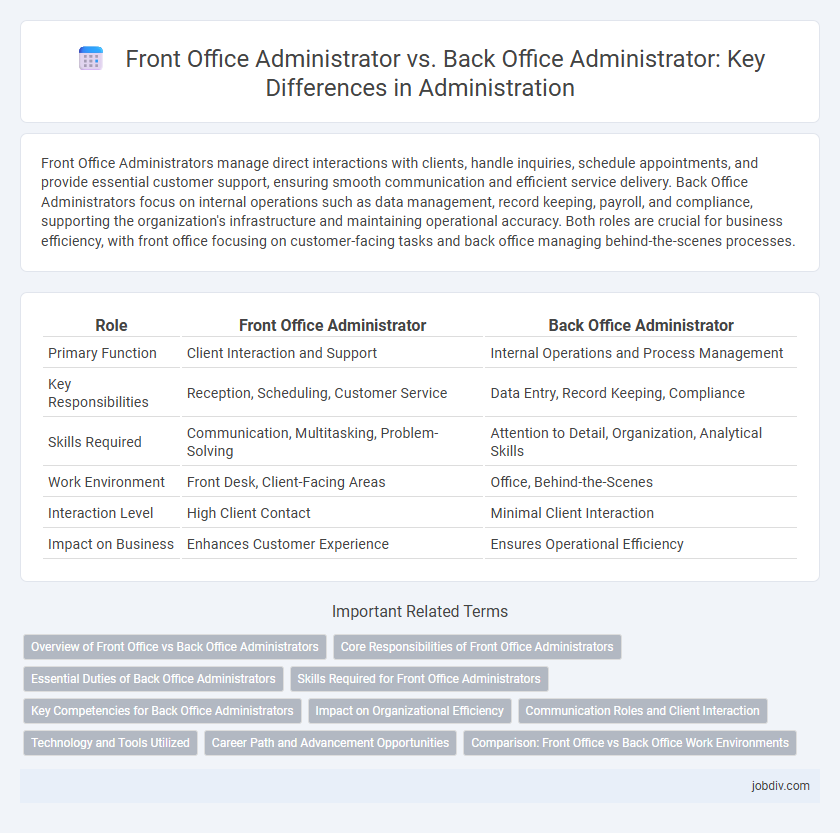Front Office Administrators manage direct interactions with clients, handle inquiries, schedule appointments, and provide essential customer support, ensuring smooth communication and efficient service delivery. Back Office Administrators focus on internal operations such as data management, record keeping, payroll, and compliance, supporting the organization's infrastructure and maintaining operational accuracy. Both roles are crucial for business efficiency, with front office focusing on customer-facing tasks and back office managing behind-the-scenes processes.
Table of Comparison
| Role | Front Office Administrator | Back Office Administrator |
|---|---|---|
| Primary Function | Client Interaction and Support | Internal Operations and Process Management |
| Key Responsibilities | Reception, Scheduling, Customer Service | Data Entry, Record Keeping, Compliance |
| Skills Required | Communication, Multitasking, Problem-Solving | Attention to Detail, Organization, Analytical Skills |
| Work Environment | Front Desk, Client-Facing Areas | Office, Behind-the-Scenes |
| Interaction Level | High Client Contact | Minimal Client Interaction |
| Impact on Business | Enhances Customer Experience | Ensures Operational Efficiency |
Overview of Front Office vs Back Office Administrators
Front Office Administrators manage direct interactions with clients, handle appointments, and oversee customer service operations, serving as the company's primary point of contact. Back Office Administrators focus on internal processes like data management, record keeping, and supporting operational workflows to ensure business efficiency. Both roles are essential in streamlining administration, with front office emphasizing customer engagement and back office prioritizing operational support.
Core Responsibilities of Front Office Administrators
Front Office Administrators are primarily responsible for managing direct interactions with clients, handling inquiries, scheduling appointments, and maintaining organized reception areas. They oversee communication channels such as phone calls, emails, and face-to-face meetings, ensuring efficient flow of information. Their role also includes coordinating visitor management and supporting front-line staff with administrative tasks to enhance customer service experience.
Essential Duties of Back Office Administrators
Back Office Administrators are responsible for managing internal operations such as data entry, record keeping, and processing transactions to ensure smooth business functions. They handle compliance, financial documentation, and support the front office by maintaining accurate databases and coordinating with other departments. Their role is critical in streamlining workflows and safeguarding organizational data integrity.
Skills Required for Front Office Administrators
Front Office Administrators require strong communication skills, proficiency in customer service, and expertise in handling multi-line phone systems and scheduling software. They must possess organizational abilities to manage appointments, greet visitors, and maintain records efficiently. Additionally, front office roles demand problem-solving aptitude and familiarity with office management tools like Microsoft Office Suite and CRM platforms.
Key Competencies for Back Office Administrators
Back Office Administrators require strong organizational skills, attention to detail, and proficiency in data management systems to efficiently handle payroll, compliance, and record-keeping tasks. Expertise in financial reconciliation, report generation, and regulatory adherence is essential to support operational accuracy and minimize risks. Effective communication and problem-solving abilities enable Back Office Administrators to collaborate with multiple departments while maintaining confidentiality and operational integrity.
Impact on Organizational Efficiency
Front Office Administrators enhance organizational efficiency by managing direct customer interactions, scheduling, and communication, which improves client satisfaction and streamlines workflow. Back Office Administrators focus on internal processes such as data management, compliance, and record-keeping, ensuring operational accuracy and regulatory adherence. Collaboration between front and back office roles drives overall productivity, reduces errors, and supports smooth business operations.
Communication Roles and Client Interaction
Front Office Administrators serve as the primary point of contact for clients, managing direct communication channels such as phone calls, emails, and face-to-face interactions to ensure prompt and professional service. Back Office Administrators handle internal communication, coordinating between departments and managing data flow to support front office functions without direct client interaction. The front office emphasizes customer engagement and relationship management, while the back office focuses on operational support and information processing.
Technology and Tools Utilized
Front Office Administrators primarily utilize customer relationship management (CRM) software, appointment scheduling tools, and communication platforms such as Microsoft Teams or Zoom to enhance client interactions and streamline front-end operations. Back Office Administrators rely heavily on enterprise resource planning (ERP) systems, database management software, and advanced accounting tools like SAP, Oracle, or QuickBooks to handle financial records, inventory, and internal workflows efficiently. Both roles leverage cloud computing technologies and cybersecurity measures to ensure data integrity and seamless operational connectivity across departments.
Career Path and Advancement Opportunities
Front Office Administrators typically advance by honing customer service and communication skills, often moving into roles such as Office Manager or Client Relations Coordinator. Back Office Administrators focus on data management, compliance, and operations efficiency, creating pathways into specialized roles like Operations Manager or Compliance Officer. Career growth for both depends on gaining expertise in relevant software, industry knowledge, and leadership abilities within sectors like finance, healthcare, or corporate administration.
Comparison: Front Office vs Back Office Work Environments
Front Office Administrators operate in dynamic, customer-facing environments requiring strong interpersonal and multitasking skills to manage client interactions and front desk operations. Back Office Administrators work behind the scenes in controlled, process-driven settings focusing on data management, record-keeping, and internal support functions. The contrast in work environments highlights front office roles as customer-centric and fast-paced, while back office roles emphasize accuracy and operational efficiency.
Front Office Administrator vs Back Office Administrator Infographic

 jobdiv.com
jobdiv.com